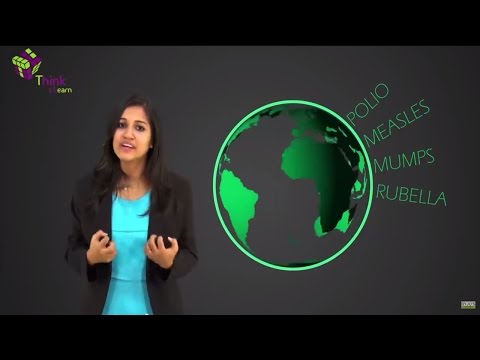What are Antimicrobial Agents?
Infections and diseases may be caused by different types of organisms like bacteria, fungi, and viruses, etc., in humans and animals. The drug used to prevent the pathogenicity of microorganisms is called an antimicrobial agent.
Examples: Antibiotics, antiseptics, and disinfectants. Let us look at some antimicrobial agents and their types with examples.
Related Topics
- Analgesics
- Tranquillizers
- Antiseptics and Disinfectants
- Antifertility Drugs
- Antibiotics
- Antacids
- Antihistamines
- Classification Of Drugs

Antimicrobial agents are used to preventing infections and diseases caused by pathogens. Different types of antimicrobial drugs are commonly available. These are as follows:
- Antibacterial drug: A drug that is used to inhibit the pathogenic activity of bacteria is called an antibacterial drug. Example: Zithromax.
- Antifungal drug: A drug that is used to prevent fungal activity in the host is called an antifungal drug. Example: Miconazole
- Antiviral agent: A drug which is used to stop the pathogenic action of a virus is called antiviral agents. Example: Tamiflu.
- Antiparasitic drug: A drug that is used to prevent the growth of pathogenic parasites. Example: Anthelmintics
Recommended Videos

Antibiotics
Antibiotics are the substances which are derived from one microorganism in order to kill another microorganism. Antibiotics are effective against bacterial, fungal and parasitic infections. But, antibiotics are not helpful against viral infections.
The development of chemical synthesis has helped to produce the synthetic components which act as an antimicrobial agent against the pathogenic bacteria. These synthetic components are also called as antibiotics. Pathogenic bacteria can be killed by synthetic components at low concentrations. Examples: Ampicillin and amoxicillin.
In 1908, a German bacteriologist, Paul Ehrlich developed a synthetic component from an arsenic-based structure for the treatment of syphilis, which is called as arsphenamine or salvarsan.
Then, in 1929, Alexander Fleming discovered Penicillin from the fungus Penicillium notatum. Penicillin is used to treat different types of bacterial infections.
Two types of antibiotics are commonly available. These are as follows:
- Bactericidal antibiotics – These antibiotics had killing effects on bacteria. Example: Penicillin, Aminoglycosides, Ofloxacin.
- Bacteriostatic antibiotics – These antibiotics have an inhibitory effect on bacteria. Example: Erythromycin, Tetracycline, Chloramphenicol.
Depending on the spectrum of action, antibiotics are further classified into three types. These are as follows:
- Broad-spectrum antibiotics: These antibiotics are widely used to kill or inhibit the Gram-positive and Gram-negative bacteria. Example: Chloramphenicol
- Narrow spectrum antibiotics: These antibiotics are widely effective against specific groups of bacteria. Example: Penicillin G
- Limited spectrum antibiotics: These antibiotics are effective against a single organism or a single disease. Example: Dysidazirine.
Antiseptics and Disinfectants
Antiseptics and disinfectants are the chemical components which are used as antimicrobial agents.
Antiseptics are applied to the injured tissues, cuts, and infected skin surfaces. Antiseptics are not prescribed to be taken orally. A few examples are given below:
- Dettol – It is a mixture of chloroxylenol and terpineol. It is used to apply in the wounds.
- Iodine tincture and iodoform – It has very good antiseptic properties.
- Boric acid – It is used as an antiseptic agent for eyes.
Disinfectants are used to destroy the pathogenic microorganisms in the non-living objects such as floors and drainage systems.
Example: Chlorine and sulphur dioxide at low concentration.
Antimicrobial Agents Uses
The use of antimicrobial agents as highly specific inhibitors has in turn substantially assisted the investigation of complex biochemical processes. While different forms of antimicrobials have been in use for decades, more customers have become aware of antimicrobial treatments for floor coverings in the past forty or so years.
Several forms of antimicrobials marketed to the carpet industry by different firms have been found to contain bacteria and fungi. From a scientific point of view, the carpet systems use three simple chemical compositions. These are organometallics, organo-silanes, and organometallics. They can also be paired with each other.
Frequently Asked Questions – FAQs
What are chemical antimicrobial agents?
Antimicrobial agent, any one of a wide variety of chemical compounds and physical agents used to destroy or prevent micro-organisms from developing. In the early 1940s, the production and use of the antibiotic penicillin became the basis for the modern antimicrobial therapy era.
How do antimicrobial agents kill bacteria?
Antimicrobial agents kill bacteria depending on the type of bacteria, by different methods. Most antiseptics and disinfectants kill bacteria immediately by causing the bacterial cell to explode or by consuming bacterial resources by preventing bacterial multiplication, they are known as bacterial conjugation.
What are synthetic antimicrobials?
Antimicrobials are agents that kill or prevent micro-organism development such as spores, bacteria, or protozoa. Drugs that use antimicrobials may either kill harmful microbes or prevent their growth.
Is antibacterial the same as disinfecting?
Disinfectants contain additives that destroy germs if surfaces are free of hard dust. Disinfectant or antibacterial cleaners contain dirt removal ingredients as well as infection killer antimicrobial ingredients. The kitchen bleach disinfects according to the instructions on the bottle as applied.
How do antimicrobials kill bacteria?
Most antiseptics and disinfectants kill bacteria immediately by causing the bacterial cell to explode or by consuming bacterial resources by preventing bacterial multiplication, they are known as bacterial conjugation. This first step, which is achieved in a sequence of stages, destroys bacteria through antimicrobial polymers.
How do antimicrobials work?
At the cellular level, antimicrobials work to constantly inhibit and deter microorganisms from developing. Antimicrobials secure consumer items like counter tops, toys, surface coatings, textiles and medical supplies by creating an inhospitable atmosphere for microorganisms such as bacteria, mould and mildew.
What are antimicrobial agents used for?
An antimicrobial is an agent that destroys, or prevents the growth of, microorganisms. It is possible to organise antimicrobial drugs according to the microorganisms in which they function primarily. Antibiotics are used against bacteria, for instance, and antifungals against fungi are used.
We have thus seen this basic introduction of antimicrobial agents. For the complete understanding of the topic, please visit our site or download BYJU’S – The Learning App.

Comments